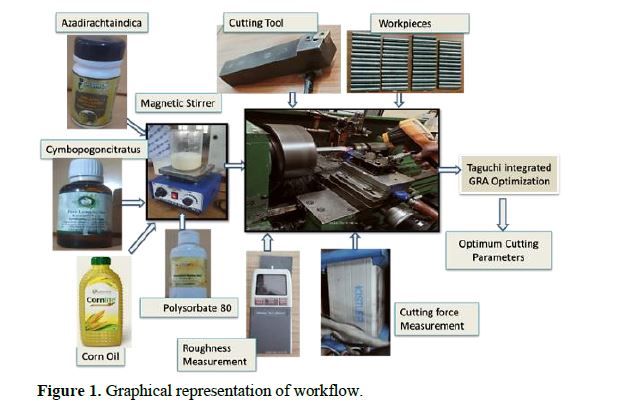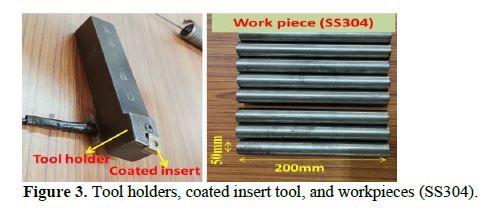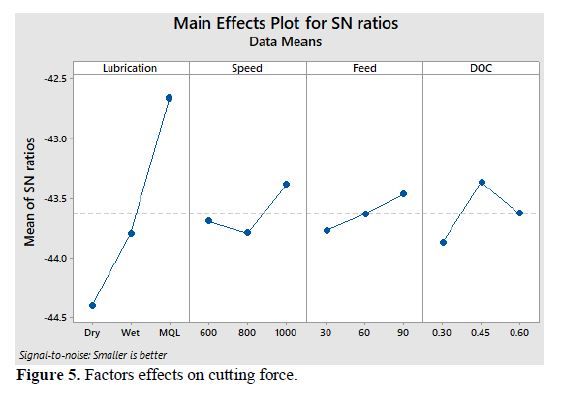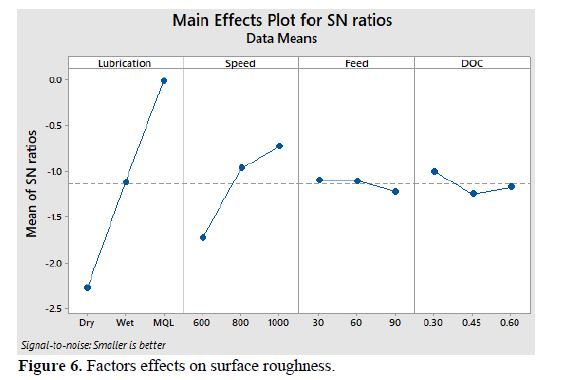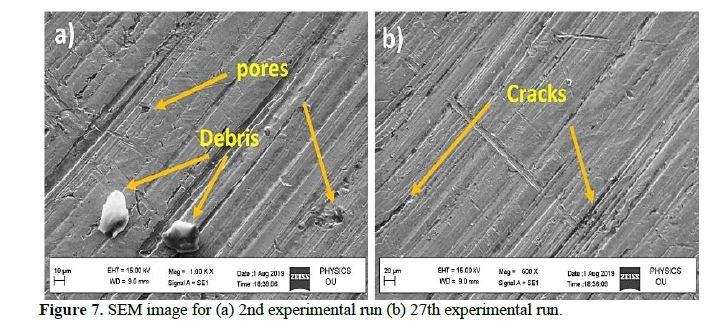Open Access

Javvadi Eswara Manikanta

B. Naga Raju

Chitrada Prasad

Naveen Kumar Gurajala

N Malleswararao Battina
- Research Scholar Trans-Disciplinary Research Hub Andhra Pradesh India
- Professor Department of Mechanical Engineering Andhra Pradesh India
- Assistant Professor Department of Physics, Aditya College of Engineering Andhra Pradesh India
- Assistant Professor Department of Mechanical Engineering, CMR College of Engineering and Technology Hyderabad India
- Assistant Professor Department of Mechanical Engineering, Shri Vishnu Engineering College for Women Andhra Pradesh India
Abstract
The machining industry’s evolving environmental consciousness has prompted a growing demand for cutting fluids devoid of chlorine and sulphur, thus fostering sustainable machining practices. This surge in demand is driven by mounting apprehensions over environmental contamination and worker safety. As the industry transitions to modern cutting fluids, it becomes imperative to comprehend their effectiveness and the optimal machine parameters required for their deployment in the turning process. In our current study, we employ the Taguchi technique in conjunction with Grey Relational Analysis (GRA) to assess the efficacy of parameter optimization and its impact on the turning of SS 304 steel, utilizing non-toxic, biodegradable vegetable-based cutting fluids. Our investigation delves into the influence of various process variables, including cooling conditions (CC), cutting speed (Vc), feed rate (f), and depth of cut (a), on critical response parameters like Cutting Force (CF) and Surface Roughness (SR). This is accomplished through rigorous Analysis of Variance (ANOVA) to identify the parameters of significant influence. The study reveals that employing the Minimum Quantity Lubrication (MQL) method at a cutting speed of 1000 revolutions per minute, a feed rate of 90 mm/minute, and a 0.3 depth of cut leads to substantial enhancements in machining performance. The microstructure of the optimized sample is investigated through the use of a Scanning Electron Microscope. Optimally, MQL machining at Vc 1000 rpm, f 90 mm/min, and a 0.3 mm minimized CF. Additionally, the type of cutting coolant (CC), a, Vc, and f contributed 77.77%, 6.54%, 4.606%, and 2.328%, respectively, to CF reduction.
Keywords: Eco friendly cutting fluids, Turning, Minimum Quantity Lubrication (MQL), Surface roughness, cutting force, Optimization.
[This article belongs to Special Issue under section in Journal of Polymer and Composites(jopc)]

Browse Figures
References
- Bedi, S.S., Behera, G.C., Datta, S.: Effects of Cutting Speed on MQL Machining Performance of AISI 304 Stainless Steel Using Uncoated Carbide Insert: Application Potential of Coconut Oil and Rice Bran Oil as Cutting Fluids. Arab. J. Sci. Eng. 45, 8877–8893 (2020). https://doi.org/10.1007/s13369-020-04554-y
- Manikanta, J.E.: Self Textured Cutting Tools in Dry Machining. 5, 356–359 (2018)
- Haque, S., Ansari, A.H., Bharti, P.K.: Experimental Evaluation of Process Parameters Effect on Mechanical and Machining Properties of Al6061–Cu–SiCp-Reinforced Metal Matrix Composite. Arab. J. Sci. Eng. 41, 4303–4311 (2016). https://doi.org/10.1007/s13369-016-2094-6
- Soni, H., Mashinini, P.M.: An Analysis on Tool-Chip Interaction During Dry Machining of SS316 Using Textured Carbide Tools. Arab. J. Sci. Eng. 46, 7611–7621 (2021). https://doi.org/10.1007/s13369-021-05499-6
- Badiger, P. V., Desai, V., Ramesh, M.R., Prajwala, B.K., Raveendra, K.: Cutting Forces, Surface Roughness and Tool Wear Quality Assessment Using ANN and PSO Approach During Machining of MDN431 with TiN/AlN-Coated Cutting Tool. Arab. J. Sci. Eng. 44, 7465–7477 (2019). https://doi.org/10.1007/s13369-019-03783-0
- Corn, M., In, O., Steel, S., Manikanta, J.E., Raju, B.N., Bhadri, R., Chekuri, R.: PERFORMANCE ASSESSMENT OF NANO ALUMINA MIXED CORN OIL IN STAINLESS STEEL. 12, 5723–5734 (2023). https://doi.org/10.31838/ecb/2023.12.8.456
- Shaikh, V.A., Boubekri, N.: Using vegetable-oil-based sustainable metal working fluids to promote green manufacturing. Int. J. Manuf. Mater. Mech. Eng. 10, 1–19 (2020). https://doi.org/10.4018/IJMMME.2020010101
- Singh, G., Aggarwal, V., Singh, S.: Critical review on ecological, economical and technological aspects of minimum quantity lubrication towards sustainable machining. J. Clean. Prod. 122185 (2020). https://doi.org/10.1016/j.jclepro.2020.122185
- Ali, M.A.M., Azmi, A.I., Murad, M.N., Zain, M.Z.M., Khalil, A.N.M., Shuaib, N.A.: Roles of new bio-based nanolubricants towards eco-friendly and improved machinability of Inconel 718 alloys. Tribol. Int. 144, 106106 (2020). https://doi.org/10.1016/j.triboint.2019.106106
- Manikanta, J.E., Naga Raju, B., Phanisankar, B.S.S., Rajesh, M., Kotteda, T.K.: Nanoparticle Enriched Cutting Fluids in Metal Cutting Operation: A Review. Lect. Notes Mech. Eng. 147–156 (2023). https://doi.org/10.1007/978-981-19-2188-9_14
- Chuang, K., Lan, T., Zhang, L., Chen, Y., Dai, X.: SS symmetry Parameter Optimization for Computer Numerical. (2019)
- Manikanta, J.E., Ganesh Gupta, B.N.V.S., Manikanta, J.T., Pradeep, R.: Integrality characterization of machining with nano cutting fluids. Int. J. Mech. Eng. Technol. 9, 1033–1042 (2018)
- Thakur, A., Gangopadhyay, S.: State-of-the-art in surface integrity in machining of nickel-based super alloys. Int. J. Mach. Tools Manuf. 100, 25–54 (2016). https://doi.org/10.1016/j.ijmachtools.2015.10.001
- Zhou, T., He, L., Wu, J., Du, F., Zou, Z.: Prediction of surface roughness of 304 stainless steel and multi-objective optimization of cutting parameters based on GA-GBRT. Appl. Sci. 9, (2019). https://doi.org/10.3390/app9183684
- Jiang, Z., Gao, D., Lu, Y., Liu, X.: Optimization of Cutting Parameters for Trade-off Among Carbon Emissions, Surface Roughness, and Processing Time. Chinese J. Mech. Eng. (English Ed. 32, (2019). https://doi.org/10.1186/s10033-019-0408-9
- Khaleeq, U., Khan, U.A., Aziz, S., Baqai, A.A., Butt, S.U., Hussain, D., Siadat, A., Jung, D.W.: Optimization of Wire Electric Discharge Machining ( WEDM ) Process Parameters for AISI 1045 Medium Carbon Steel Using Taguchi Design of Experiments. (2022)
- Pinar, A.M.: Optimization of Process Parameters with Minimum Surface Roughness in the Pocket Machining of AA5083 Aluminum Alloy via Taguchi Method. Arab. J. Sci. Eng. 38, 705–714 (2013). https://doi.org/10.1007/s13369-012-0372-5
- Akkuş, H.: Optimising the effect of cutting parameters on the average surface roughness in a turning process with the Taguchi method. Mater. Tehnol. 52, 781–785 (2018). https://doi.org/10.17222/mit.2018.110
- Arulraj, M., Palani, P.K., Venkatesh, L.: Optimization of machining parameters in turning of hybrid aluminium-matrix (Lm24-Sic p -coconut shell ash) composite. Mater. Tehnol. 53, 263–268 (2019). https://doi.org/10.17222/mit.2018.184
- Tlhabadira, I., Daniyan, I.A., Masu, L., VanStaden, L.R.: Process design and optimization of surface roughness during M200 TS milling process using the Taguchi method. Procedia CIRP. 84, 868–873 (2019). https://doi.org/10.1016/j.procir.2019.03.200
- Vasu, M., Shivananda, N.H.: Comparative study of coated and uncoated tool inserts with dry machining of EN47 steel using Taguchi L9 optimization technique. AIP Conf. Proc. 1943, (2018). https://doi.org/10.1063/1.5029639
- Das, B., Roy, S., Rai, R.N., Saha, S.C.: Development of an in-situ synthesized multi-component reinforced Al–4.5%Cu–TiC metal matrix composite by FAS technique – Optimization of process parameters. Eng. Sci. Technol. an Int. J. 19, 279–291 (2016). https://doi.org/10.1016/j.jestch.2015.08.002
- Das, B., Roy, S., Rai, R.N., Saha, S.C.: Application of grey fuzzy logic for the optimization of CNC milling parameters for Al–4.5%Cu–TiC MMCs with multi-performance characteristics. Eng. Sci. Technol. an Int. J. 19, 857–865 (2016). https://doi.org/10.1016/j.jestch.2015.12.002
- Gupta, A., Singh, H., Aggarwal, A.: Taguchi-fuzzy multi output optimization (MOO) in high speed CNC turning of AISI P-20 tool steel. Expert Syst. Appl. 38, 6822–6828 (2011). https://doi.org/10.1016/j.eswa.2010.12.057
- Anggoro, P.W., Purharyono, Y., Anthony, A.A., Tauviqirrahman, M., Bayuseno, A.P., Jamari: Optimisation of cutting parameters of new material orthotic insole using a Taguchi and response surface methodology approach. Alexandria Eng. J. 61, 3613–3632 (2022). https://doi.org/10.1016/j.aej.2021.08.083
- Li, C., Xiao, Q., Tang, Y., Li, L.: A method integrating Taguchi, RSM and MOPSO to CNC machining parameters optimization for energy saving. J. Clean. Prod. 135, 263–275 (2016). https://doi.org/10.1016/j.jclepro.2016.06.097
- Ajith Arul Daniel, S., Pugazhenthi, R., Kumar, R., Vijayananth, S.: Multi objective prediction and optimization of control parameters in the milling of aluminium hybrid metal matrix composites using ANN and Taguchi -grey relational analysis. Def. Technol. 15, 545–556 (2019). https://doi.org/10.1016/j.dt.2019.01.001
- Thankachan, T., Soorya Prakash, K., Malini, R., Ramu, S., Sundararaj, P., Rajandran, S., Rammasamy, D., Jothi, S.: Prediction of surface roughness and material removal rate in wire electrical discharge machining on aluminum based alloys/composites using Taguchi coupled Grey Relational Analysis and Artificial Neural Networks. Appl. Surf. Sci. 472, 22–35 (2019). https://doi.org/10.1016/j.apsusc.2018.06.117
- Tamiloli, N., Venkatesan, J., Vijaya Ramnath, B.: A grey-fuzzy modeling for evaluating surface roughness and material removal rate of coated end milling insert. Meas. J. Int. Meas. Confed. 84, 68–82 (2016). https://doi.org/10.1016/j.measurement.2016.02.008
- Rapeti, P., Pasam, V.K., Rao Gurram, K.M., Revuru, R.S.: Performance evaluation of vegetable oil based nano cutting fluids in machining using grey relational analysis-A step towards sustainable manufacturing. J. Clean. Prod. 172, 2862–2875 (2016). https://doi.org/10.1016/j.jclepro.2017.11.127
- Sarikaya, M., Güllü, A.: Multi-response optimization of minimum quantity lubrication parameters using Taguchi-based grey relational analysis in turning of difficult-to-cut alloy Haynes 25. J. Clean. Prod. 91, 347–357 (2015). https://doi.org/10.1016/j.jclepro.2014.12.020
- Sarikaya, M., Güllü, A.: Taguchi design and response surface methodology based analysis of machining parameters in CNC turning under MQL. J. Clean. Prod. 65, 604–616 (2014). https://doi.org/10.1016/j.jclepro.2013.08.040
- Jian, B., Wang, C., Yau, H.: Optimization of Lathe Cutting Parameters Using Taguchi Method and Grey Relational Analysis. 32, 843–858 (2020)
- Patole, P.B., Kulkarni, V. V: Prediction of surface roughness and cutting force under MQL turning of AISI 4340 with nano fl uid by using response surface methodology. 5, (2018)
- Eswara, J., Raju, B.N., Prasad, C., Sankar, B.S.S.P.: Machining performance on SS304 using nontoxic, biodegradable vegetable-based cutting fluids. Chem. Data Collect. 42, 100961 (2022). https://doi.org/10.1016/j.cdc.2022.100961

Journal of Polymer and Composites
| Volume | 11 |
| Special Issue | 12 |
| Received | October 30, 2023 |
| Accepted | January 5, 2024 |
| Published | April 1, 2024 |


